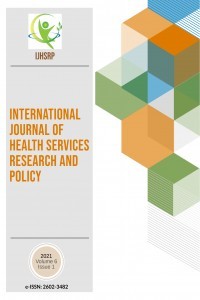INVESTIGATION OF THE EFFECT OF EXERCISE ON IRISIN HORMONE IN EXPERIMENTALLY INDUCED DIABETIC RATS
INVESTIGATION OF THE EFFECT OF EXERCISE ON IRISIN HORMONE IN EXPERIMENTALLY INDUCED DIABETIC RATS
Investigating the possible effects of the irisin hormone, which has been discovered in recent years, on energy expenditure and glucose metabolism has been found to have positive effects on end-stage diseases. The irisin secreted by the skeletal muscle in mice and humans; is a hormone thought to improve energy consumption and improve systemic metabolism by making white fat tissue turn into brown fat tissue. Thanks to the knowledge that the structure of the irisin hormone is 100% similar in rats and humans, researches on experimental animals may be helpful for human studies. It has been suggested that irisin, which has been studied in particular for its positive effects on obesity and diabetes, may be a promising alternative treatment for metabolic diseases. In our study that we have planned, we aimed to determine the changes that exercise will bring about at the level of irisin hormone in diabetic animal models that will be created experimentally and to evaluate the effects of these changes on diabetes, insulin resistance, lipid profile, obesity and inflammation from Metabolic Syndrome components. For this purpose, we have 3 groups; control group, diabetic and diabetic exercise group. The effects of exercise on the level of irisin hormone were investigated in the obtained serum samples. In order to observe the obesity process, the rats in each group were weighed weekly and their body weights were measured. When the weights of the groups at the beginning and 4 weeks were observed, a mean increase of 35.8 g (p <0.05) was observed in the control group, 30 g (p <0.05) in the diabetic group and 59 g in the diabetic exercise group (p> 0.05). The mean fasting blood glucose value of the diabetic group was 477.17 ± 87.98 mg / dl and the diabetic exercise group had a mean of 485 ± 86.03 mg / dl. When the irisin levels were examined, it was seen that there was a difference between the groups (p> 0.05). In the control group, average irisin level was 255.73 ± 374.81 ng/ml, in the diabetic group was 98.09 ± 51.25 ng/ml and in the diabetic exercise group was of 66.43 ± 25.01 ng/ml. As a result, injectable irisin forms are produced because of irisin hormone is an important alternative in the treatment of obesity and diabetes as well as other metabolic diseases; it can be thought that the frequency can be used to control diabetes and obesity which are increasing day by day.
___
- Yrd. Doç. Dr. Rojan GÜMÜŞ
- Yayın Aralığı: Yılda 3 Sayı
- Başlangıç: 2016
- Yayıncı: Rojan GÜMÜŞ
Sayıdaki Diğer Makaleler
INVESTIGATION OF THE EFFECT OF EXERCISE ON IRISIN HORMONE IN EXPERIMENTALLY INDUCED DIABETIC RATS
Hazal KÜÇÜKKARACA, Mehtap ÜNLÜ SÖĞÜT
Menşure Nur ÇELİK, Mehtap ÜNLÜ SÖĞÜT
Gül Eda KILINÇ, Mehtap ÜNLÜ SÖĞÜT
NICOTINE DEPENDENCE LEVEL OF UNIVERSITY STUDENTS RELATING TO TYPE OF EDUCATION AND GENDER
Songül DOĞANAY, Ayla Eren ÖZDEMİR, Şeyma TRABZON
Elham NASER KAMJOO, Maryam NASER KAMJOO
THE PREVALENCE OF TAS2R38 GENE PHENOTYPES AMONG THE PATIENTS WITH SOME ENDOCRINE SYSTEM DISORDERS
Rusudan KHUKHUNAİSHVİLİ, Marina KORİDZE, Sophiko TSKVİTİNİDZE, Nato ZOSİDZE, Marina NAGERVADZE, İrakli PARULAVA
